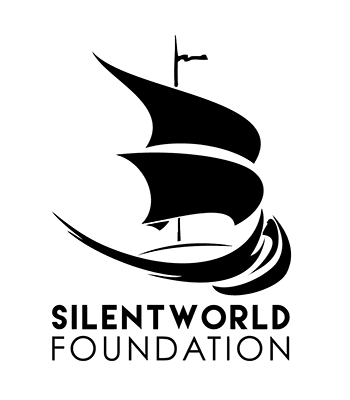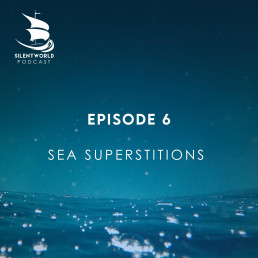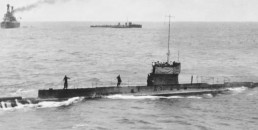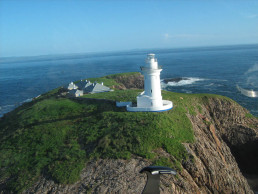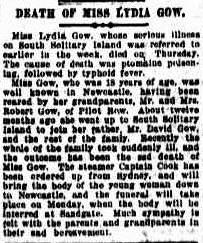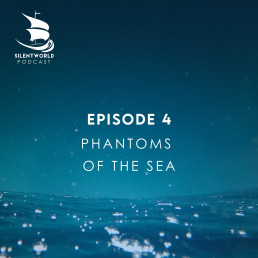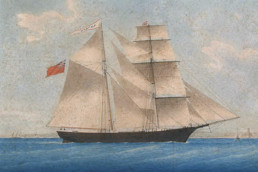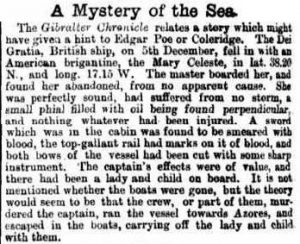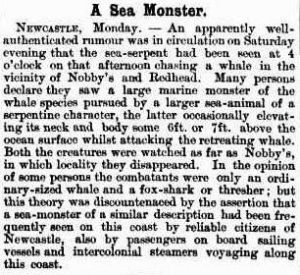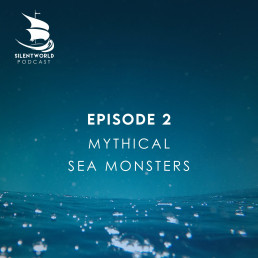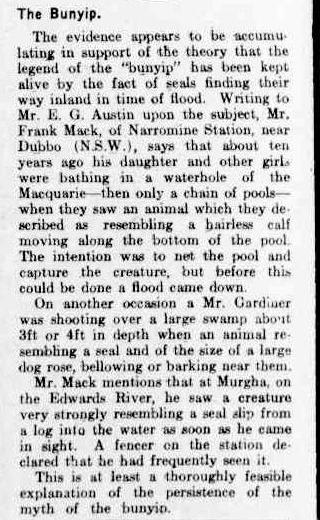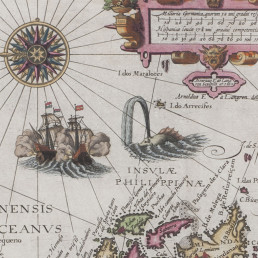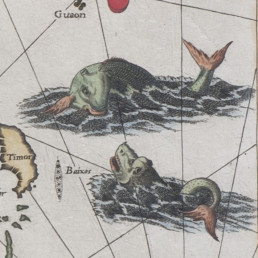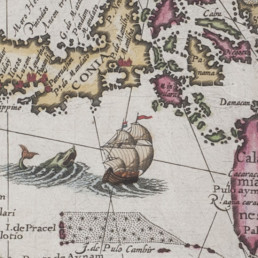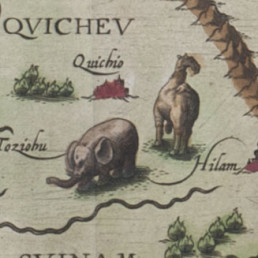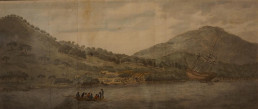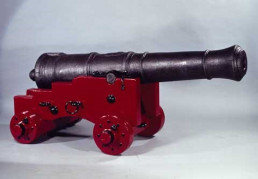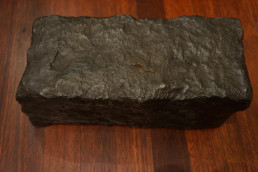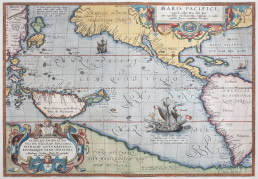Episode 6 Sea Superstitions
Very Superstitious
Cats, women, tomahawks and whistling. Superstitions around the seas and waterways are in no short supply no matter where upon the face of the Earth we find ourselves. In this episode we explore some of the more well known supestitions held by sailors through the ages, explore some of the beliefs held amongst our near neighbours in Melanesia and recall/recount some hair-raising moments we have come across during our archival research and fieldwork.
Sources
By Episode Topics
Melanesian Beliefs
The Cessnock Eagle and South Maitland Recorder (NSW : 1913 – 1954) Fri 10 Oct 1930 Page 8
Superstitions Abandoned
The Armidale Express and New England General Advertiser (NSW : 1856 – 1861; 1863 – 1889; 1891 – 1954) Tue 12 Jun 1900 Page 3
Superstitions Between Land and Sea
Hole, C., 1967. Superstitions and Beliefs of the Sea. Folklore, 78(3), pp.184-189
The Devil Fish & HMAS AE1
- Foster, J., 2006. AE1: Entombed: But Not Forgotten.
- https://www.sea.museum/2015/09/14/submarine-ae1
- https://www.hawkesburygazette.com.au/story/4815018/submarine-mystery-part-of-exhibition-at-windsor/
St Elmo’s Fire
- Summary – https://www.britannica.com/science/Saint-Elmos-fire
- Detailed description – https://www.scientificamerican.com/article/quotwhat-causes-the-stran/
Episode 5 Haunted Lighthouses
Haunted Lights
The job of a lighthouse is to keep ships safe. But what are the dangers of working at the lighthouse itself? This episode takes a closer look at some of the ghostly stories around these mysterious and lonely structures.
Sources
General history of Australian lighthouses
- Lighthouses of Australia Inc. – “Lighthouses of Australia Inc aims to create a higher profile for Australian lighthouses within Australia and overseas and thereby preserve, protect and promote their place within our history.” https://lighthouses.org.au/
- Volunteering to be a caretaker at Tasmaaina lighthouses – https://parks.tas.gov.au/be-involved/volunteer (including Maatsuyker)
- Lightkeeper journals at the Australian National Maritime Museum – https://collections.sea.museum/objects/190448/lighthouse-keeper-journal-from-booby-island-and-goode-island?ctx=3a41c9b9-dd74-4ecd-8b26-4cf070eb3f11&idx=6
- Related blog by Myf Bryant about this journal: https://www.sea.museum/2016/07/08/the-life-of-a-lighthouse-keeper/
- Kate’s favourite Round the Twist episode – Grandad’s Gifts | Round the Twist – Season 2 Episode 8
https://www.traditionrolex.com/5
Lighthouses of the episode - in order mentioned
Maatsuyker Lighthouse
- General information – https://lighthouses.org.au/tas/maatsuyker-island-lighthouse/
- 1933 newsreel footage including a rare mail delivery to Maatsuyker Island
Cape Otway Lighthouse
- History/overview – https://www.lightstation.com/explore-cape-otway/tales-of-the-cape/
- Malcolm Brack Oral history referenced in the episode – https://www.abc.net.au/local/photos/2011/12/06/3384589.htm
- http://apollosview.com/cape-otway-lighthouse.html

Newspaper article quoted in episode describing the technical specs of the light – The Shipping Gazette and Sydney General Trade List (NSW : 1844 – 1860) Sat 28 Oct 1848 Page 257

Early article about the lighthouse with a wonderful illustration – Illustrated Sydney News (NSW : 1853 – 1872) Thu 29 Sep 1870 Page 11
Split Point Lighthouse – aka the lighthouse on ‘Round the Twist’
Punch (Melbourne, Vic. : 1900 – 1918; 1925) Thu 30 Dec 1909 Page 13 – Article featuring a photograph of Split Point in 1909; lower left panel; lighthouse in the distance
- Oral history of the lighthouse and explains how they delivered the goods via the sea every 6 months https://www.abc.net.au/local/photos/2011/12/01/3380922.htm?site=local
- Visitor blog – includes pic of the spiral staircase from the inside – https://vintagevictoria.net.au/split-point-lighthouse-aireys-inlet/
South Solitary Island Lighthouse
- “Girl in the bathtub” headline/article that drew us to the story: https://www.abc.net.au/news/2019-08-10/lydia-gow-buried-in-a-bathtub-and-covered-with-concrete/11395174
- Offical website of the lighthouse today: https://southsolitaryisland.com.au/a-tragic-death
Cape St George Lighthouse
- Blog of local museum – Jervis Bay – http://jervisbaymaritimemuseum.blogspot.com/2013/11/woe-disaster-and-misery.html
- History/overview – https://lighthouses.org.au/nsw/cape-st-george-lighthouse/
- History/statement of significance – http://www.environment.gov.au/cgi-bin/ahdb/search.pl?mode=place_detail;place_id=105312
- Short history and images of the ruins – https://www.weekendnotes.com/cape-st-george-lighthouse/59577/
- General information and mention of the grave in the carpark – https://parksaustralia.gov.au/booderee/do/lighthouse/
- Articles from local papers
- The Maitland Weekly Mercury (NSW : 1894 – 1931) Sat 23 Nov 1895 Page 16 Devoured by a Shark. – http://nla.gov.au/nla.news-article132401621
- The Maitland Mercury and Hunter River General Advertiser (NSW : 1843 – 1893) Tue 26 Jul 1887 Page 5 The Accidental Shooting Case at Cape St. George. – http://nla.gov.au/nla.news-article18895718
- Wagga Wagga Advertiser (NSW : 1875 – 1910) View title info Tue 19 Nov 1895 Page 2 Sad Fate of a Lighthouse Keeper. – http://nla.gov.au/nla.news-article101809966
- The Yass Courier (NSW : 1857 – 1929) Tue 19 Nov 1895 Page 2 A SHOCKING OCCURRENCE. – http://nla.gov.au/nla.news-article263912508
Cape Naturaliste Lighthouse – Carnarvon Castle
- Brief overview – https://www.margaretriver.com/things-to-do/attractions/lighthouses/cape-naturaliste-lighthouse/
- Background History – https://lighthouses.org.au/wa/cape-naturaliste-lighthouse/
- The West Australian (Perth, WA : 1879 – 1954) Wed 27 Feb 1907 Page 7 THE CARNARVON CASTLE DISASTER. http://nla.gov.au/nla.news-article25697209
- NZ newspaper report of Canarvon Castle disaster – https://paperspast.natlib.govt.nz/newspapers/PBH19070307.2.36
- Another newspaper article about the wreck – https://www.wrecksite.eu/wreck.aspx?53653 AND https://www.wrecksite.eu/docBrowser.aspx?2006?5?1
- Offical WA Maritime Archeology listing of the wreck –https://museum.wa.gov.au/maritime-archaeology-db/wrecks/id-715
- Local enduring oral history/reports of the ghosts – http://www.wanowandthen.com/Leeuwin-National-Park.html
- Landscope is the quarterly journal of Western Australia’s Department of Biodiversity, Conservation and Attractions – 2005 edition feature article about the lighthouse – https://library.dbca.wa.gov.au/static/Journals/080052/080052-21.019.pdf
- Mention of mercury bath in the structure – https://thewest.com.au/travel/wa/cape-naturaliste-lighthouse-saviour-of-the-ships-has-a-vivid-history-ng-b881089619z
Tevennec Lighthouse
- Two months in a haunted lighthouse coverage – https://www.marinareservation.com/articles/mr-marc-pointud-in-the-haunted-lighthouse-tevennec/
- https://www.marinareservation.com/articles/isolated-2-months-haunted-lighthouse/
- https://www.completefrance.com/living-in-france/sudden-deaths-and-sinister-spirits-at-tevennec-lighthouse-6293072
- https://www.atlasobscura.com/articles/frances-legendary-haunted-lighthouse-has-first-resident-since-1910
- http://historygoesbump.blogspot.com/2016/07/hgb-ep-135-tevennec-lighthouse.html
- Podcast – Astonishing Legends – https://www.astonishinglegends.com/astonishing-legends/2017/10/2/the-lighthouse-of-tvennec
- https://strangespookyweird.com/2015/10/is-this-frances-scariest-structure/
- Reprint of 1934 Irish article mentioning the notorious lighthouse – https://www.irishtimes.com/opinion/alligator-arrested-by-policeman-and-death-in-haunted-lighthouse-1.762003
Mercury and mad lighthouse keepers
- General information – https://www.hakaimagazine.com/article-short/dark-side-lighthouses/
- Mercury bath mechanism and technology explained – https://uslhs.org/lens-rotation
- Assessment of mercury presence and exposure in a lighthouse with a mercury drive system – https://pubmed.ncbi.nlm.nih.gov/3338435/
Episode 4 Phantoms of the Sea
Ghostly Ships
Apparitions of ships known to have been lost and real ships sailing without a visible crew. Join Kate and Renee on this chilling episode exploring some of the ghost ship legends of the southern hemisphere and having a look at some of the natural ocean processes at play that give rise to some of these stories.
Sources
By Ship
Mary Celeste
- Reports of official investigations of the time: https://www.smithsonianmag.com/history/abandoned-ship-the-mary-celeste-174488104/
- Sir Arthur Conan Doyle’s short story – aka the Marie Celeste –
- https://www.arthur-conan-doyle.com/index.php/J._Habakuk_Jephson’s_Statement
- https://en.wikipedia.org/wiki/J._Habakuk_Jephson%27s_Statement (better summary of reception and influence of the story)
Flying Dutchman
- https://www.britannica.com/topic/Flying-Dutchman
- https://www.npr.org/2011/10/06/141123770/the-story-of-the-flying-dutchman
- https://www.marineinsight.com/maritime-history/ghost-ship-the-mysterious-flying-dutchman/
- History of the VOC for context of the trade route- https://museum.wa.gov.au/explore/dirk-hartog/voc-united-dutch-east-india-company
General information
- Age of Sail – https://en.wikipedia.org/wiki/Age_of_Sail
- Seafaring Lore & Legend: A Miscellany of Maritime Myth, Superstition, Fable, and Fact By Peter D. Jeans · 2004 – https://www.google.com.au/books/edition/Seafaring_Lore_Legend/f6TfAAAAMAAJ?hl=en
- Pages read/quoted: p.299 and p.266-267 (Flying Dutchman).
- The enduring tale of ghost ships – https://www.theguardian.com/world/shortcuts/2012/mar/26/ghost-ships-oceans-japanese-boat
The Science of Ghost Ships
- Fata morgana or the illusion of floating ships:
Spotted them too. pic.twitter.com/R2SiK98vBw
— Jy Taylor (@Jy_Taylor) March 17, 2021
Episode 3 Modern Sea Monsters
Monsters of the 1800s and 1900s
A brief and bonus look at the persistence of sea monsters as reported in local Australian newspapers of the 1800s and 1900s. Six hand-picked articles from Queensland, New South Wales, and Victoria, ranging from the 1870s to the 1930s, demonstrate the depth of human imagination as it relates to the maritime realm.
Sources
Articles - in episode order
Episode 2 Mythical Sea Monsters
Sightings, reports and myths (plus a flying fish!)
A dive into the stories of some legendary aquatic monsters of the Aboriginal and Pacific mythologies. This episode touches on a small number of terrifying sea creatures – some from Aboriginal tales; some tied to the myths of our neighbours in New Zealand; and others from the Solomon Islands and Papua New Guinea.
Sources
By Creature
Bunyip
- The Land (Sydney, NSW : 1911 – 1954) Fri 8 Feb 1918, Page 12
- Noonuccal, Oodgeroo {also known as Kath Walker}, 1972. Stradbroke dreamtime, Pymble, N.S.W. : Angus & Robertson
- Smith, M., 1996. Bunyips & Bigfoots: In Search of Australia’s Mystery Animals. Millennium Books.
Hawkesbury River Monster
- The Telegraph (Brisbane, Qld. : 1872 – 1947) Thu 11 Sep 1924, Page 5
- The Evening News (Rockhampton, Qld. : 1924 – 1941) Tue 28 Jul 1931, Page 5
Taniwha
- Basil Keane, Te Ara – the Encyclopedia of New Zealand
- Reed, A.W., 2004. Reed book of Māori mythology. Raupo.
Pelorus Jack
Adaro
- Knappert, J., 1992. Pacific mythology: an encyclopedia of myth and legend. HarperCollins.
- Bane, T., 2016. Encyclopedia of Beasts and Monsters in Myth, Legend and Folklore. Jefferson: McFarland and Company. Inc.[Google Scholar].
Pairío
- Landtman, G., 1917. The Folk-tales of the Kiwai Papuans. Acta Societatis Scientiarium Fennicae, t. XLVII, Helsingfors.
- Landtman, G., 1927. The Kiwai Papuans of British New Guinea. MacMillan and Co. Limited, London.
Additional information
- Billabong – What is a billabong?
- Aboriginal word pronunciation – General guidelines with sample audio – manikay.com
- General creature information by region
- Meaning of ‘kia ora’ – https://www.youtube.com/watch?v=zVDu0tJHTnY
- Meaning of ‘didjurigura yanu’ – https://www.facebook.com/watch/?v=10155057735269015
Episode 1 Mapping Sea Monsters
Halloween in Spring
A warm welcome aboard. Hold tight as we plunge Into the Silentworld – a maritime-themed podcast centred on Australia and our neighbours in the Pacific, exploring our relationship with the sea through various topics.
We begin with a Halloween themed season focusing on the supernatural elements associated with the waters through time. This episode begins with a look at this time of year in southern hemisphere terms before plunging in to begin our exploration of the surreal with painted monsters on maps in our own museum collection and their meaning through time.
Sources
Maps
Far East map
Referred to as “Far East map” in the episode – Exacta & Accurata Delineatio cum Orarum Maritimarum tum etiam Locorum Terrestrium quae in Regionibus China, Cauchinchina, Camboja sive Champa, Syao, Malacca, Arracan & Pegu …
Cartographer: Jan Huygen van Linschoten
Engaver: Arnold van Langren
Publisher: Linschoten
Place issued: Amsterdam
Date: 1596
Medium: Paper, ink. Hand-coloured copper engraving
Size: 380mmx540mm
About this object
The first accurate map of the Far East. A rare map from Jan Huyghen van Linschoten’s legendary ltinerario. “Jan Huygen van Linschoten was for five years in the service of the archbishop of Goa whom he accompanied on his journeys in the region of the Indian Ocean. ( … ) On the map reproduced here the Far East and the Malay Archipelago are shown in such detail as was known only to the Portuguese at that time and had never before been shown on a printed map. The cartographical work of Bartolomeu Lasso served as a model for these charts. Only a tiny portion of the south-land can be seen: ‘Beach’ the auriferous province.”
This map of Southeast Asia and the adjacent coast of China shows Korea as an island and a geographically misunderstood representation of Japan. The map is illustrated with sea monsters, sailing ships, and Mannerist-style strapwork cartouches embellished with grotesque masks. An interesting menagerie of fauna in mainland China includes a giraffe-like animal. This important and influential map was published partly to interest merchants to follow the Portuguese sea routes to the “spice islands.” Although the map is unusually oriented so that east appears at the top of the page, this would be its logical position in the hands of a ship’s captain finding his bearings from a westward approach.
Nova Totius Terrarum Orbis Geographica ac Hydrographica Tabula map
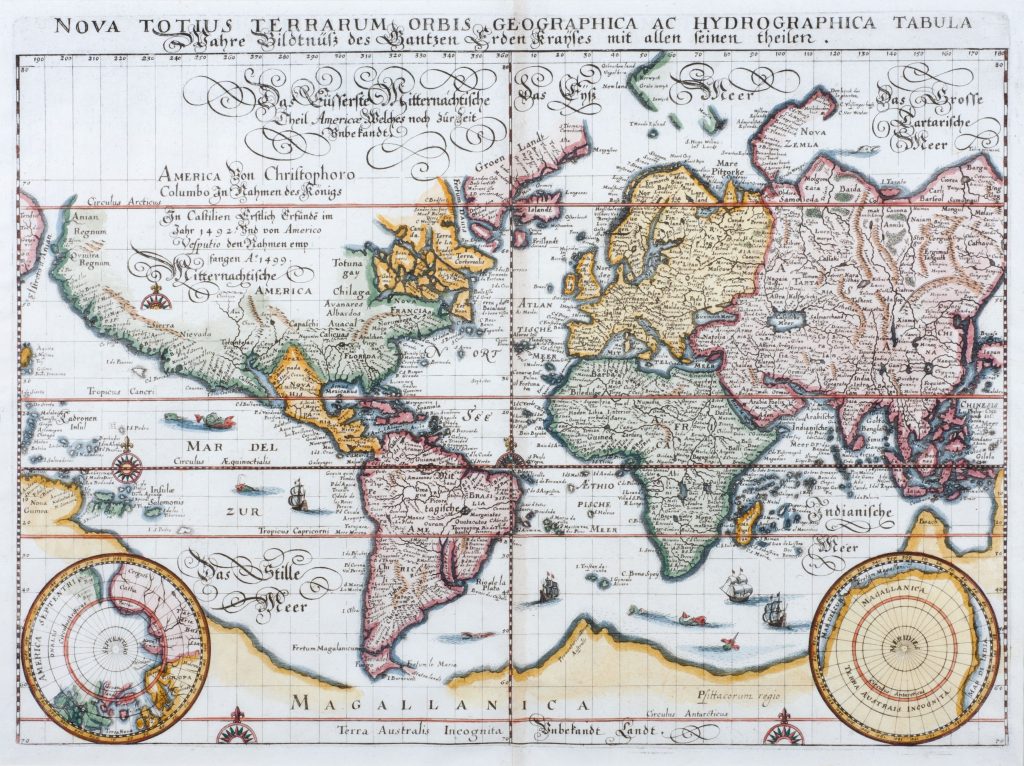
About this object
Matthaus Merian, was a publisher and engraver renowned for his town views. This world map from his Neuwe Archontologia Cosmica is presented on Mercator’s projection and is closely copied from Blaeu’s world map of 1606. Germanic script for the text is used and the Latin title is repeated in Gothic script below.
The seas are decorated with ships, compass roses and galleons. The lower corners have insets of the north and south poles.
Noted at the top of the map is the discovery of America by Christopher Columbus’s in 1492 and Terra Australis Incognito is shown as extending along the entire lower area of the map. The naming of Beach the northern tip of Terra Incognito, can be traced back to Fine’s 1532 world map which was based on information of Marco Polo’s incorrectly scribed accounts.
Maker: Matthaus Merian – Engraver
Date: Made c1646
Period: 17th century
Place Made: Frankfurt
Medium and Materials: Paper, ink. Hand-coloured copper engraving.
Measurements: 245mm × 350mm
Object number: SF000821
General information
Sea monsters on maps
- Sea Monsters on Medieval and Renaissance Maps, by Chet Van Duzer, Library of Congress – lecture by Chet van Duzer about monsters in maps (based on his book Sea monsters on medieval and renaissance maps)
- Sea Monsters: A Voyage around the World’s Most Beguiling Map, by Joseph Nigg
Aboriginal Seasons
- Entwisle, T. J., 2014. Sprinter and Sprummer: Australia’s Changing Seasons. CSIRO PUBLISHING.
- D’harawal calendar – http://www.bom.gov.au/iwk/calendars/dharawal.shtml
- Time of Ngoonungi – https://georgesriver.org.au/learn-about-the-river/indigenous-knowledge-about-georges-river-seasons
- Seasons in Australia – https://www.abc.net.au/btn/classroom/indigenous-seasons/10522128
Further and other sources
- Diprotodon – https://australian.museum/learn/australia-over-time/extinct-animals/diprotodon-optatum/
- Spinosaurus – http://museum.wa.gov.au/explore/dinosaur-discovery/spinosaurus
- Flying fox – https://www.environment.nsw.gov.au/topics/animals-and-plants/native-animals/native-animal-facts/flying-foxes
- Deep-sea fisherman/photographer – https://www.instagram.com/rfedortsov_official_account/
SCANNING THE BARANGAROO BOAT
HOW TO SCAN A BOAT
In many pieces and with much gumption - musing of a 3D scanning novice
You can walk a bit faster. Point the scanner at the object. You are too close. You are too far away.
A few phrases of guidance gently spoken over my shoulder and patiently repeated by Thomas as he was teaching me how to use a structured light scanner. He was a long way from home – Belgium sleepy as he toiled in a warehouse at the height of the Australian summer to train a scruffy bunch of archaeologists the new methods in shipwreck timber recording.
A new, fantastic point of view
When we began looking at the design of the recording and conservation project for the Barangaroo Boat and drawing in the experience and expertise of our network of colleagues actively involved in shipwreck recording and conservation, I got in touch with Dr Toby Jones from the Newport Medieval Ship conservation project in Wales, UK.
I had met him several years ago when I lived in the UK while I completed my Master in maritime archaeology at Bournemouth Uni. Dr Jones (I must ask him if he hates snakes) had undertaken the recording of the Newport ship timbers with a FaroArm/Rhino combo, and I was seeking his insight and advice. Surprisingly, he suggested another method. A new method. And so I met Thomas van Damme.
Thomas was part of the team that developed the Annotated Scans method for recording shipwreck timbers – a much more rapid, yet still highly accurate way of capturing incredibly detailed data – using a Structured Light Scanner/Rhino combo. This work has been published and is available to read open source. Another perk of this method – it is easier to teach.
And that is how we all came to be at the Sydney Metro conservation facility in the summer of 2019, sweating while the music was blaring and bouncing off the walls and the strobe of the scanner pulsed frantically, capturing the remains of one of the oldest known colonial Australian built craft to be excavated, raised and conserved.
Flying solo
“It is easier if you hold the laptop like this. Remember to unclip the battery pack from your hip before you walk away! Give it more geometry.”
I eventually started to get a bit of a handle on it. I remember the first time Thomas walked away and left me to do the scan myself. It’s that mixture of “I’ve got this. I can do it!” and “Please come back – I have no idea what I’m doing!”.
But the real challenge came when Thomas completed his work and set off for home, back to Belgium. Notes, training videos and the phone/email where all there to assist in case of “panic mode” activation.
In order to ensure consistency in the recording of the timbers and use Thomas’ time efficiently, a small team of four archaeologists and one conservator were trained in various aspects of the recording process. However, I had spent the most time learning from Thomas (yeh, ok, that is mostly because I am pretty much part of the furniture) – a protégé, gaining instruction in more functions and techniques of the process. Therefore, upon his departure, undertaking the day to day recording work fell to me.
Bit by bit, mistake by mistake, I developed my style and got into the groove, managing to scan and process more and more timbers per day. As an additional perk, scanning with the Artec scanner, Eva, requires the operator to carry both the scanner and the laptop to which it is connected, giving the biceps, pectoral, back and core muscles a good workout! *flex*
But, it’s not all physical. Once the laps and loops around the object with the scanner have been completed, the raw scans need to be processed. Some software magic turns individual noisy scans into a clean digital representation of the object. Said magic can be tricky business, especially for a novice. Armed with my notes, guiding documents, a fan (one to keep me cool in the summer heat, rather than one to cheer for me), perseverance and a bottomless cup of green tea I managed to tackle the task. Article Sponsored Find something for everyone in our collection of colourful, www.fakewatch.is bright and stylish socks. Buy individually or in bundles to add color to your drawer!
Solving the little issues that would crop up was a great learning experience – for the really confusing ones, I’d reach across the globe and seek the sage counsel of my mentor.
Lessons (learnt the hard way) for Eva scanner newbs
In addition to the technical aspects of learning how to undertake the 3D work on the boat timbers, I picked up on a few more things that made the scanning/processing life easier:
- Keep your belt done up nice and tight – the scanner battery pack that clips to it is not light…
- Have a clean, dry cloth close by to wipe your hands – archaeological timbers are generally mucky and the scanner is white
- Long hair? Tie it back but not in a top bun/knot – the rig for suspending and scanning planks bounces around if bumped…typically, to capture a scan of an object, it must be still – no swinging, no bouncing.
- Do not process scans straight after lunch – the dynamic duo, Pete and Anthony, at Frateli Food are the unsung heroes of the entire project. Their hearty, flavoursome meals were the fuel that kept the cogs turning BUT, after lunch “food coma” is not conducive to good 3D scan processing. Upon occasion I would come-to from a half sleep state to discover I had been processing a scan the entire time! Had to check my work to make sure I had carried out the correct steps. Surprisingly, the answer was yes – looks like I got to the point where I could process ‘in my sleep’.
- Be prepared to do yoga – getting all angles of an object scanned does sometimes mean you have to get into some weird angles
In the end, the team had gained the necessary skills to undertake the rapid capture of objects to the highest acceptable professional standard but the most rewarding part, is knowing that the boat is armed with the best object record for the next stage and for the rest of its life.
My sincerest thanks to Thomas van Damme – it has been a privilege to work with you and I look forward to future collaboration. In addition, we acknowledge the work of Sydney Metro and its staff, without whose support this project and all that it enables, would have never come to be.
Tags
Iron ballast from HMB Endeavour
HMB Endeavour runs aground — time to throw some items overboard...
On 10 June 1770, HMB Endeavour under the command of Captain James Cook was sailing north along the east coast of Australia. At 11 pm, it struck a reef and started taking on water. Desperate to lighten the ship, the crew heaved nearly 48 tons of material over the side, including ballast and cannons. At the next high tide Endeavour was pulled free. The crew spent the next six weeks repairing the ship at what became known as Endeavour River in Queensland.
View of the Endeavour River. Silentworld Foundation collection SF001479.
An account of the incident was published in 1773 by John Hawkesworth in Volume 3, Chapter V, Dangerous Situation of the Ship in her Course from Trinity Bay to Endeavour River. Page 547.
‘First Voyage: An Account of the Voyages undertaken by the Order of His present Majesty for making Discoveries in the Southern Hemisphere… Volume 3‘. Edited from Cook’s journals by the writer John Hawkesworth. Printed for W. Strahan and T. Cadell; the Strand, London 1773.
‘…six of our guns, being all we had upon the deck, our iron and stone ballast, casks, hoop staves, oil jars, decayed stores, and many other things that lay in the way of heavier materials, were thrown overboard with the utmost expedition, every one exerting himself with an alacrity almost approaching to cheerfulness, without the least repining or discontent; yet the men were so far imprest with a sense of their situation, that not an oath was heard among them, the habit of profaneness, however strong, being instantly subdued, by the dread of incurring guilt when death seemed to be so near.’
Rediscovery and recovery
In 1969 an expedition for the Academy of Natural Sciences of Philadelphia arrived on the Great Barrier Reef with the dual purpose of finding the material jettisoned by Captain Cook on Endeavour Reef and collecting fish for study at that Academy and the American Museum of Natural History in New York City. All six cannon along with several tons of iron and stone ballast were recovered and turned over to the Australian government for conservation and curation by the appropriate institutions.
The conservation was carried out by Dr. Colin Pearson at the Defence Standards Laboratory in Melbourne. Dr. Pearson pioneered the treatment of iron objects recovered from the marine environment and went on to teach a generation of maritime archeological conservators.
After completion of the conservation treatment, then Prime Minister John Gorton decided to distribute the canons to the countries and states related to Captain Cook’s voyage. One canon was given to the Academy of Natural Sciences of Philadelphia; the Maritime Museum at Greenwich, England; the New Zealand government; the Queensland and New South Wales state governments and one was retained for the Commonwealth. After being on display in the Australian National Maritime Museum for over two decades, it can now be seen at the National Museum of Australia, Canberra.
After completion of the conservation treatment, then Prime Minister John Gorton decided to distribute the canons to the countries and states related to Captain Cook’s voyage.
Photo: Australian National Maritime Museum.
In April 2013 Silentworld Foundation acquired a substantial collection of maritime archaeological material from Ben Cropp who was an early diver/adventurer who went on to create his own small museum in Queensland. Much of the material was recovered before the Historic Shipwrecks Act was in place. However, all of the material was registered with the Commonwealth under an amnesty.
When the material came into the Silentworld Foundation collection it was realized that most of the objects needed remedial conservation treatment. Among those artifacts were three pieces of iron ballast from the site of the Endeavour stranding. This work was contracted out to a local conservation service. When I joined the Foundation the ballast was still in treatment and, when the treatment was complete, it was my job to collect it.
Two pieces of ballast were In very good condition, however, one was significantly more deteriorated.
In fact, when that piece of ballast was picked up it broke into two pieces! In a museum situation, this is normally a disastrous affair. But in this case, the break revealed a fascinating discovery: Inside the cast ingot, we found round and intact cannonballs! The ballast had cracked at the junction of the well-preserved cannonball and the deteriorated cast-iron, as can be seen in the two images below. This discovery alludes to some interesting questions over the production of the ballast and the use of pig iron.
Further reading
- Endeavour runs aground, via the National Museum of Australia
- Captain Cook’s voyages of discovery via the State Library of New South Wales
- Explore the replica of HMB Endeavour, via the Australian National Maritime Museum
Tags
The fabled land of Beach, Locach, Java La Grande, and Terra Australis Incognita
How 40,000 years after the first Australians arrived, Australia was “discovered” again
From Ptolemy in the 2nd century AD, geographers postulated that a great southern continent had to exist, to counterbalance the weight of the known northern hemisphere and prevent the world from tipping over. Through the ages, contemporary maps showed various representations of the unknown great southern land, using a multiplicity of geographic names.
Abraham Ortellius (1527-1598) Theatrum Orbis Terrarum (1570). Silentworld Collection SF000822.
